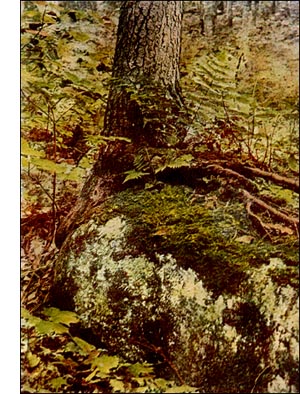Brachythecium Starkii Moss
 Brachythecium Starkii, (Brid.) Br. & Sc.
Brachythecium Starkii, (Brid.) Br. & Sc.Habit and habitat.--In dark-green, loose mats on fallen logs and old tree-trunks in moist mountain regions.
Name.-The specific name was given in honour of Robert M. Starke.
Plant (gametophyte).-Prostrate, branching, the branches ascending, arched, 1/4 to 1 inch long.
Leaves.-Branch-leaves distant, spreading, oval, lance-shaped, narrowly acute or taper-pointed; apex usually half twisted: base somewhat decurrent; margin serrate; vein extending beyond the middle; cells, the middle linear, the basal shorter and broader; the alar few, rhomboidal to quadrate; stem-leaves broadly oval and long taper-pointed, less strongly serrate, cells looser.
Leaves at the base of the pedicel (perichaetial leaves).-Longer and narrower.
Habit of floaering.-Male and female flowers on one plant (monoicous).
Veil (calyptra).-Split up one side.
Spore-case.-Abruptly horizontal, short egg-shaped, dark redbrown, black when old.
Pedicel (seta).-Rough, red-brown, 1 to 1/4 inches high.
Lid (operculum).-Convex, conical, tipped with a short, sharp point.
Annulus.-Large, of about two rows of cells.
Teeth (peristome).-As in the genus.
Spores.-Chestnut, maturing in autumn and winter.
Distribution-In the northern United States and Canada, across the continent, south to New Jersey; Europe.